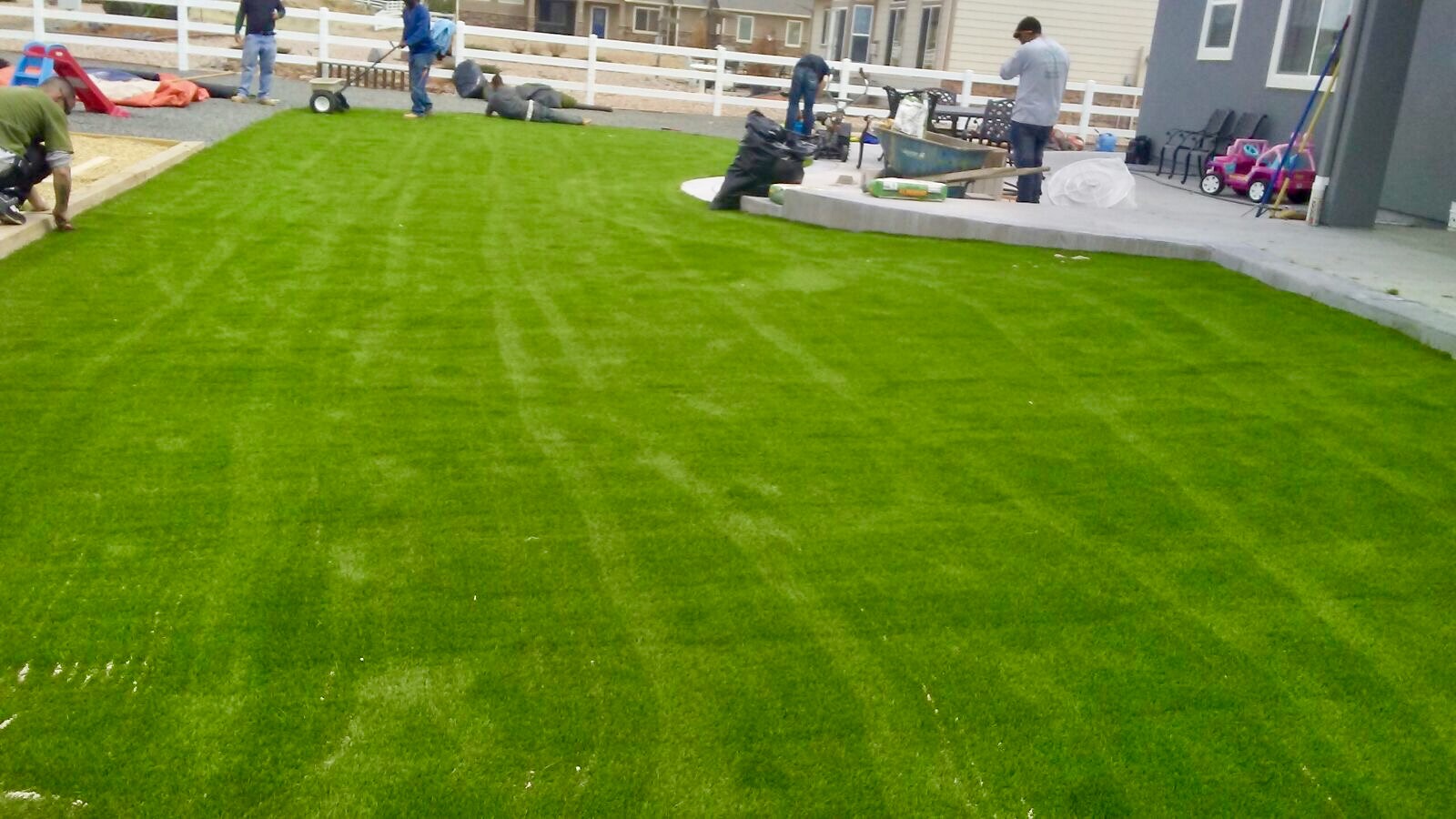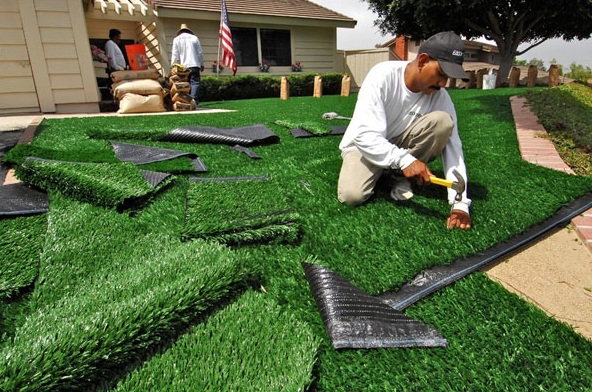Enhance Your Yard with Professional Turf Installation Phoenix AZ Services
Look Into the Environmental Conveniences of Opting for Synthetic Grass Solutions
The fostering of fabricated turf solutions offers a compelling chance to resolve pushing environmental difficulties. By significantly decreasing water usage and decreasing the application of dangerous chemicals, these alternatives not just promote lasting landscaping but additionally safeguard neighborhood ecological communities.
Water Conservation Perks
One of the most considerable advantages of man-made turf is its ability to save water. Traditional yard lawns need considerable irrigation, specifically in locations prone to dry spell or water limitations. On the other hand, synthetic grass does not need watering, significantly lowering the overall demand for water resources. This attribute is specifically useful in deserts where water shortage is a pushing problem.
By getting rid of the need for regular watering, synthetic grass adds to sustainable landscape techniques and assists alleviate the ecological impact of extreme water consumption. The preservation of water prolongs to the reduction of overflow, which can lead to soil disintegration and river pollution.
In addition, the setup of man-made turf enables municipalities and home owners to designate water resources more effectively, concentrating on necessary usages such as drinking water and agriculture. The shift towards synthetic grass not only promotes responsible water usage but additionally aligns with more comprehensive environmental objectives focused on protecting natural deposits.
As neighborhoods significantly prioritize sustainability, the water conservation advantages of synthetic grass provide a compelling case for its fostering in commercial and household landscape design tasks.
Lowered Chemical Usage
The change to synthetic grass considerably reduces the reliance on chemical therapies commonly utilized in natural grass upkeep. Conventional turf management usually involves the application of chemicals, plant foods, and herbicides to advertise growth and control insects. These chemicals can position dangers to human health and wellness, regional wild animals, and the environment, adding to dirt and water contamination.
In comparison, synthetic turf eliminates the requirement for these damaging substances. By reducing the launch of synthetic substances into the environment, synthetic lawn advertises much healthier dirt and water systems.
Furthermore, the absence of chemical runoff linked with synthetic grass setups assists shield neighborhood waterways from contamination, supporting aquatic life and keeping biodiversity. Artificial turf companies phoenix. As areas significantly prioritize lasting methods, selecting man-made turf presents a practical solution that lines up with ecological preservation objectives. With this change, homeowner can enjoy lush green spaces without compromising ecological wellness, paving the method for a more lasting future
Reduced Carbon Impact

Additionally, the installation of synthetic grass can lead to significant water preservation. All-natural yards need significant quantities of water for irrigation, which not just contributes to the carbon impact associated with water removal and therapy however additionally stress local water like it resources. On the other hand, artificial grass requires minimal upkeep, requiring no watering, consequently dramatically minimizing water use and its associated power costs.
Furthermore, the long life of artificial grass adds to its lower carbon influence. With a lifespan of up to 15 years or more, the need for regular substitutes is diminished, leading to less waste and reduced energy usage in production and dealing with standard grass options. In general, synthetic grass offers a lasting alternative for environmentally aware landscaping.
Habitat Preservation
Habitat conservation is a critical factor to consider in the discussion over landscape design options, especially when comparing synthetic turf to natural grass. All-natural lawn lawns usually require substantial upkeep, consisting of making use of plant foods, pesticides, and herbicides, which can adversely influence regional ecological communities. These chemicals can leach into the dirt and waterways, harming indigenous flora and animals and interfering with regional environments.
On the other hand, man-made turf offers a possibility to minimize the ecological impact of landscape design. By selecting artificial turf, property owners can lessen the interruption of natural habitats linked with standard yard care techniques. Fabricated grass eliminates the demand for unsafe chemicals, thus safeguarding neighboring wild animals and maintaining the stability of bordering communities. In addition, the installation of synthetic lawn can lead Click This Link to the conversion of former lawn locations into more biodiverse landscapes, such as pollinator yards or native plant locations, which can sustain neighborhood wildlife.
Ultimately, the shift to synthetic grass not just preserves water and lowers upkeep efforts however also fosters a more unified partnership between human activities and the native environment, advertising habitat conservation in the procedure.
Long-Term Sustainability
Lasting sustainability is an essential factor in evaluating the advantages of artificial turf over traditional lawn lawns. Among the most significant advantages of synthetic grass is its resilience; it can last up to 15-20 years with marginal maintenance, whereas all-natural yard needs constant reseeding and substitute. This long life decreases the need for consistent resources, such as water, fertilizers, and pesticides, which are vital for maintaining a healthy and balanced grass yard.
Additionally, artificial lawn contributes to a decrease in carbon emissions connected with grass care tools. Standard lawns usually need gas-powered lawn mowers, trimmers, and blowers, every one of which add to air contamination. Artificial turf companies phoenix. In comparison, man-made turf removes the demand for such equipment, advertising a cleaner atmosphere
Moreover, the manufacturing of synthetic turf progressively uses recycled materials, enhancing its sustainability profile. As producers take on eco-friendly methods, the ecological impact of synthetic turf remains to decrease.

Final Thought
The adoption of synthetic grass services provides considerable environmental advantages, including considerable water conservation, minimized reliance on harmful chemicals, and a lower carbon footprint. Furthermore, synthetic turf aids in protecting natural habitats by minimizing land disturbance and promoting long-lasting sustainability via the usage of sturdy products. Collectively, these elements underscore the possibility of synthetic grass to add positively to environmental wellness and use a sensible option to conventional landscaping methods in an increasingly resource-conscious globe.
In contrast, synthetic lawn does not require watering, dramatically minimizing the overall need for water resources. By minimizing the launch of synthetic substances into the ecosystem, man-made grass promotes much healthier dirt and water systems.
Additionally, the installment of synthetic turf can result in significant water preservation. In contrast, synthetic grass needs minimal upkeep, go to this site requiring no watering, consequently considerably minimizing water use and its connected energy prices.
